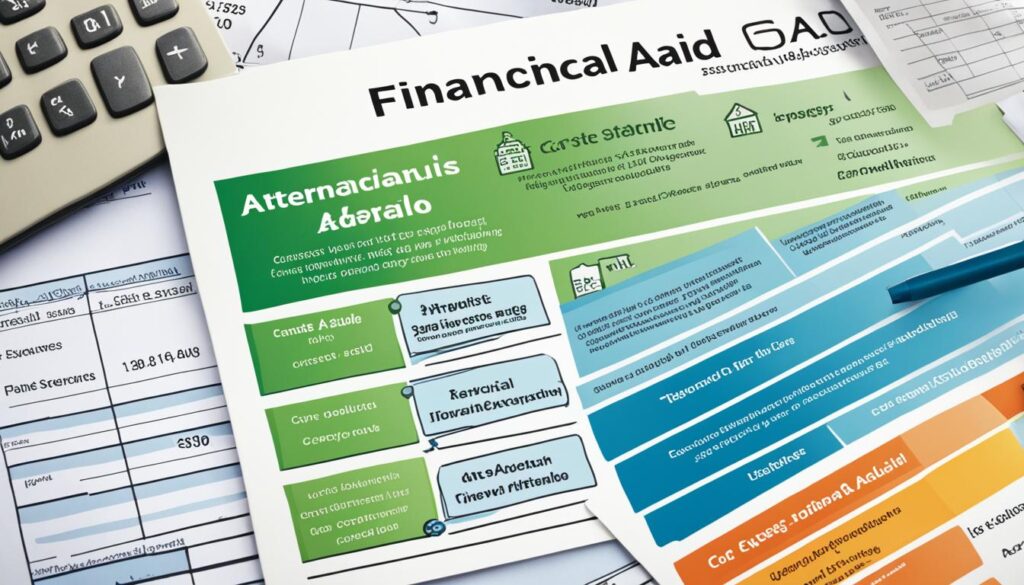Student loans have become an essential part of financing higher education for many individuals. However, navigating the complex world of student loans can be overwhelming and confusing for borrowers. It’s crucial for students and their families to have a solid understanding of the key details surrounding student loans, such as repayment plans, loan forgiveness options, and the differences between federal and private student loans.
Key Takeaways:
- Understanding the various types of student loans, including federal and private loans, is essential in making informed borrowing decisions.
- Repayment options, such as income-driven repayment plans and loan consolidation, provide flexibility for borrowers to manage their student loan debt effectively.
- Loan forgiveness and discharge programs offer relief to eligible borrowers, depending on specific circumstances like public service employment or disability.
- Defaulting on student loans can have serious consequences, negatively impacting credit history and leading to collections activity.
- Completing the FAFSA and understanding the cost of attendance are crucial steps in accessing financial aid and planning for the total cost of education.
Also Read : how to pay off car loan faster
Types of Student Loans
When it comes to financing higher education, student loans are a popular option for many borrowers. However, it’s important to understand the different types of student loans available to make informed decisions. In general, student loans can be classified into two main categories: federal student loans and private student loans.
Federal student loans are loans offered by the Department of Education through various loan programs. These loans generally offer more favorable terms and conditions compared to private student loans. Let’s take a closer look at the different types of federal student loans:
- Direct Loans: Direct loans are the most common type of federal student loans. They are offered directly by the Department of Education.
- Unsubsidized Loans: Unsubsidized loans are available to both undergraduate and graduate students. Unlike subsidized loans, interest accrues on unsubsidized loans while the borrower is in school.
- PLUS Loans: PLUS loans are available to graduate or professional students and parents of dependent undergraduate students. These loans require a credit check and may have higher interest rates compared to other federal loan options.
- Subsidized and Unsubsidized Loans: Subsidized Stafford Loans are need-based loans available to undergraduate students. The interest on subsidized loans is paid by the government while the borrower is in school or during deferment periods.
Also Read : how to get pre approved for a car loan
On the other hand, private student loans are offered by banks, credit unions, and other lending institutions. These loans typically have fewer borrower protections and may have higher interest rates compared to federal student loans. Unlike federal student loans, private loans are not backed by the government.
It’s important to carefully consider your options before choosing between federal and private student loans. Each type of loan has its own advantages and disadvantages, so it’s crucial to assess your financial situation, repayment plans, and eligibility requirements to make an informed decision.
Also Read : how to sell a car with a loan
Repayment Options
Repaying student loans can be challenging, but there are various repayment options available to borrowers. Understanding these options can help borrowers find a plan that fits their financial situation and allows them to manage their debt effectively. Let’s explore some of the most common repayment options:
1.
Income-Driven Repayment Plans:
These repayment plans are tailored to a borrower’s income and family size, making monthly payments more affordable. They calculate payments based on a percentage of the borrower’s discretionary income. Income-driven repayment plans include options such as Pay As You Earn (PAYE), Income-Based Repayment (IBR), and Income-Contingent Repayment (ICR).
2.
Extended Repayment:
This plan extends the repayment period, resulting in lower monthly payments. Borrowers can choose to extend their repayment term up to 25 years, depending on their loan amount. Keep in mind that extending the repayment term may increase the overall interest paid.
3.
Graduated Repayment:
Graduated repayment plans start with lower monthly payments that increase every two years. This option is suitable for borrowers who expect their income to increase over time. Graduated repayment plans usually have a maximum repayment term of 10 years.
4.
Loan Consolidation:
Loan consolidation combines multiple federal student loans into a single loan, simplifying repayment. It can lower monthly payments by extending the repayment term and may provide access to different repayment plans. However, it’s essential to consider the potential impact on interest rates and benefits associated with the original loans.
5.
Forbearance:
Forbearance offers temporary relief by allowing borrowers to suspend or reduce their loan payments. It is typically granted for specific circumstances, such as financial hardship or medical expenses. However, interest may continue to accrue during forbearance, resulting in a higher overall loan balance.
It’s important for borrowers to assess their financial situation and determine which repayment option is most suitable for them. Consulting a loan servicer or a financial advisor can provide valuable guidance in selecting the right plan.
Also Read : how to get a startup business loan with no money

Comparison of Repayment Options:
| Repayment Option | Key Features |
|---|---|
| Income-Driven Repayment Plans | Based on income and family size, affordable payments |
| Extended Repayment | Lower monthly payments, extended repayment term |
| Graduated Repayment | Payments start low and increase over time |
| Loan Consolidation | Simplifies repayment, potential for lower payments |
| Forbearance | Temporary relief from payments, interest may accrue |
Understanding the available repayment options empowers borrowers to make informed decisions and tailor their repayment strategy to their financial circumstances. Remember to stay engaged with your loan servicer and explore potential federal loan forgiveness or discharge programs that you may qualify for.
Also Read : Unlock Value with Home Equity Loan Options
Loan Forgiveness and Discharge
Student loan forgiveness and discharge programs provide relief to borrowers who meet certain criteria. These programs are designed to alleviate the financial burden of student loan debt by forgiving or discharging the outstanding balance.
One such program is the Public Service Loan Forgiveness (PSLF) program. It offers loan forgiveness to individuals working in qualifying public service positions, such as government or non-profit organizations, after making 120 qualifying payments. This program can be especially beneficial for borrowers who have high loan balances and lower incomes.
Discharge options are available for borrowers experiencing total and permanent disability or death. In the case of disability discharge, borrowers need to provide documentation from a qualified physician or the Social Security Administration confirming that they are unable to engage in substantial gainful activity due to a physical or mental impairment. Death discharge relieves the borrower’s estate from the responsibility of repaying the loans.
Another program, called borrower defense to repayment, provides relief to borrowers who were defrauded by their school. Under this program, borrowers who prove that their school engaged in fraudulent activity or misled them can apply for loan forgiveness. Successful claims can result in a full or partial discharge of the loans.
| Loan Forgiveness and Discharge Programs | Eligibility Criteria |
|---|---|
| Public Service Loan Forgiveness (PSLF) | 120 qualifying payments while working in public service |
| Disability Discharge | Total and permanent disability confirmed by a qualified physician |
| Death Discharge | Death of the borrower |
| Borrower Defense to Repayment | Proof of fraud or misleading conduct by the school |
It is essential for borrowers to understand the requirements and application procedures for these loan forgiveness and discharge programs. Each program has its own specific criteria, documentation requirements, and application process. Seeking guidance from a student loan counselor or consulting official government resources can help borrowers navigate these programs successfully.

Default and Consequences
Defaulting on your student loans can have serious consequences that impact your financial future. It is essential to understand the potential ramifications of default and take proactive steps to avoid it.
What is default?
Default occurs when you fail to make loan payments for an extended period of time. For federal student loans, default typically happens after missing payments for more than 270 days. With private student loans, default can occur even sooner, often after just four missed payments.
The consequences of default
Defaulting on your student loans can have severe consequences that affect various aspects of your financial life:
- Credit history: Defaulting on student loans has a negative impact on your credit history. This can make it difficult for you to qualify for future loans, credit cards, or other types of financing.
- Collections activity: When your loan goes into default, your loan servicer may transfer your debt to a collections agency. This can lead to aggressive collections activity such as phone calls, letters, or even legal actions.
- Credit bureaus: Defaulted loans are reported to credit bureaus, which can further damage your credit score. This negative information can stay on your credit report for up to seven years, making it challenging to rebuild your credit.
Defaulting on your student loans can have far-reaching consequences that impact your financial well-being for years to come. It is essential to take timely action to prevent default and protect your creditworthiness.
Taking action to avoid default
If you are struggling to make your loan payments, it is important to reach out to your loan servicer as soon as possible. They may be able to offer options such as:
“Loan repayment plans, deferment or forbearance programs, or even loan forgiveness options depending on your circumstances.”
Taking advantage of these alternative arrangements can help you avoid default and maintain good standing on your student loans.

By understanding the consequences of default and taking proactive steps to manage your student loans, you can protect your financial future and avoid the long-term negative impact of default.
Financial Aid and Cost of Attendance
When it comes to funding higher education, financial aid is an essential resource for many students. By completing the Free Application for Federal Student Aid (FAFSA), students can determine their eligibility for federal student aid.
But what exactly does financial aid cover? It includes different types of assistance to help students pay for their education, such as grants, scholarships, and work-study programs. These forms of aid can significantly reduce the burden of educational expenses.
However, it’s crucial to understand the total cost of attendance (COA) before making any decisions. The COA encompasses various expenses, including tuition, fees, housing, meals, books, and other education-related costs. By calculating the COA, students can better plan their budget and avoid any unexpected financial challenges.
Completing the FAFSA
The first step to accessing federal student aid is to complete the FAFSA. This form collects information about the student’s and their family’s financial situation, which determines their eligibility for aid. It’s important to submit the FAFSA as early as possible to maximize the chances of receiving financial aid.
Once the FAFSA is submitted and processed, the student will receive a Student Aid Report (SAR). The SAR includes the Expected Family Contribution (EFC), which represents the amount of money the student’s family is expected to contribute towards their education. The financial aid package will be based on this EFC.
Types of Financial Aid
There are different types of financial aid available, including:
- Grants: These are funds that don’t need to be repaid. They are typically awarded based on financial need or specific criteria.
- Scholarships: Similar to grants, scholarships are also funds that don’t require repayment. They are awarded based on academic achievements, talent, or other criteria.
- Work-Study Programs: These programs offer part-time employment opportunities to students, allowing them to earn money to cover their educational expenses.
- Loans: Unlike grants and scholarships, loans need to be repaid with interest. They can be obtained through federal student aid programs or private lenders.
Understanding Financial Aid Offers
After completing the FAFSA, students will receive financial aid offers from the schools they applied to. These offers outline the types and amounts of financial aid the student is eligible to receive. It’s essential to carefully review these offers and compare them to determine the best option.
Consider factors such as the total cost of attendance, the distribution of grants and scholarships versus loans, and the repayment terms of any offered loans. This evaluation will help students make informed decisions about their funding options and minimize the need to rely heavily on loans.
| Financial Aid Type | Description |
|---|---|
| Grants | Funds that do not require repayment. |
| Scholarships | Financial assistance based on specific criteria. |
| Work-Study Programs | Part-time employment opportunities for students. |
| Loans | Funds that need to be repaid with interest. |

By understanding the impact of financial aid on the cost of attendance, students can make informed decisions about their educational journey. It’s essential to explore all available financial aid options and carefully evaluate the terms and conditions associated with each. With proper planning and utilization of financial aid resources, students can obtain the necessary funding while managing their student loan debt effectively.
Deferment and Forbearance
When it comes to managing student loan payments, borrowers have options to help alleviate financial burdens temporarily. Two such options are deferment and forbearance, which allow borrowers to pause or reduce their student loan payments for a certain period of time.
Deferment is typically granted for specific situations such as active duty military service, reenrollment in school, or undergoing economic hardship. During deferment, borrowers are granted a temporary pause in their loan payments. The key difference between deferment and forbearance is that depending on the type of loan, interest may or may not accrue during deferment. It is essential for borrowers to understand the terms and conditions of deferment based on their specific loan type.
Forbearance, on the other hand, is typically granted when borrowers experience financial difficulties. It allows borrowers to temporarily pause or reduce their loan payments, providing some relief during challenging times. However, it’s important to note that unlike deferment, interest may accrue during forbearance, increasing the overall cost of the loan. Borrowers should carefully consider whether forbearance is the best option for their individual financial situation.
Both deferment and forbearance can be valuable tools for borrowers facing temporary financial difficulties or major life events. However, it is crucial to review the terms, conditions, and potential consequences of each option before making a decision. By understanding the implications of deferment and forbearance, borrowers can make informed choices that best suit their needs and financial circumstances.

| Deferment | Forbearance |
|---|---|
| Granted for specific situations | Granted for financial difficulties |
| May or may not accrue interest | May accrue interest |
| Pause or reduction in loan payments | Pause or reduction in loan payments |
| Terms and conditions vary based on loan type | Terms and conditions vary based on loan type |
Income-Driven Repayment Plans
Income-driven repayment plans offer borrowers flexibility in managing their student loan payments based on their income and family size. These plans adjust monthly payments to ensure they are affordable, taking into account a borrower’s financial situation. By capping payments at a certain percentage of discretionary income, income-driven repayment plans help alleviate the burden of high monthly payments.
One of the key advantages of income-driven repayment plans is the potential for loan forgiveness. After making a certain number of qualifying payments, borrowers may be eligible for loan forgiveness. This means that a portion, or even the entire remaining balance of their student loan, can be forgiven. The number of qualifying payments and repayment thresholds vary depending on the specific plan.
There are several different income-driven repayment plans available, each with its own eligibility requirements and repayment terms. Some of the most common plans include:
- Revised Pay As You Earn (REPAYE)
- Income-Based Repayment (IBR)
- Pay As You Earn (PAYE)
- Income-Contingent Repayment (ICR)
These plans offer varying repayment terms and forgiveness options. For example, REPAYE and IBR plans have different repayment thresholds, with REPAYE typically capping payments at 10% of discretionary income for most borrowers, while IBR typically caps payments at 15% of discretionary income. Loan forgiveness is available after 20 or 25 years of qualifying payments, depending on the plan.
It’s important for borrowers to carefully consider their options and choose the income-driven repayment plan that best suits their financial situation. Calculating the monthly payments and exploring the potential for forgiveness can help borrowers make an informed decision. Additionally, borrowers should regularly review their income and family size with their loan servicer to ensure their payments are accurately adjusted.
Note: The image above depicts an example of how income-driven repayment plans adjust monthly payments based on income and family size.
Refunds and Forgiveness Review
The government is currently conducting a thorough review of borrower accounts to determine eligibility for loan forgiveness. This review focuses on borrowers who have been diligently making payments on their federal student loans for a decade or more. The goal is to identify those who may qualify for forgiveness and provide them with the relief they deserve.
Unfortunately, many borrowers have missed out on forgiveness opportunities due to confusing rules and mismanagement by loan servicers. This has left individuals unaware of their eligibility and the potential benefits they could have received. However, the government’s commitment to rectifying this issue has led to a promising solution for borrowers.
If you have diligently made payments on your federal student loans for the required length of time, you may be eligible for a refund of payments made beyond the point of eligibility for loan cancellation. This is a major development that aims to rectify past oversight and provide borrowers with the financial respite they deserve.
In order to determine if you are eligible for a refund, it is important to review your payment records and ensure that you have met the necessary criteria. Loan servicers play a crucial role in this process, as they are responsible for accurately documenting your payment history and assessing your eligibility for forgiveness. If you have any concerns or questions about your eligibility, it is recommended to contact your loan servicer directly.
Benefits of Refunds and Forgiveness Review:
- Opportunity for refunds of payments made beyond the point of eligibility
- Rectification of confusion caused by complex forgiveness rules
- Potentially significant financial relief for borrowers
- Enhanced transparency and accountability in the loan forgiveness process
Borrowers, who have faithfully fulfilled their repayment obligations, should not miss out on the benefits they are entitled to. The refunds and forgiveness review initiative aims to address this issue by ensuring that borrowers receive the forgiveness they deserve and the refunds they may be eligible for.
Stay informed and regularly check for updates from your loan servicer regarding the refunds and forgiveness review. By understanding your eligibility and actively seeking the benefits available to you, you can make the most of this opportunity and alleviate the burden of student loan debt.
| Key Points | Benefits |
|---|---|
| Review of borrower accounts | Ensures accurate assessment of eligibility for forgiveness |
| Refunds of payments made beyond eligibility | Provides financial relief to borrowers |
| Improved transparency in loan forgiveness | Enhances borrower trust and confidence |
| Opportunity to rectify past oversights | Addresses missed forgiveness opportunities |
Restarting Payments and Flexibilities
The temporary pause on student loan payments is set to end, and borrowers will need to resume making payments. This transition from the repayment pause to restarting payments can be a significant change for borrowers, but the Department of Education has introduced flexibilities to assist in this process.
Repayment Transition Programs
To help borrowers ease back into repayment, the Department of Education has implemented several programs designed to provide flexibility during this transition. One such program is the “on ramp” program, which allows borrowers to make missed payments without facing negative consequences or penalties. This can be particularly helpful for borrowers who may have experienced financial hardship during the repayment pause.
In addition, the Department of Education offers a “Fresh Start” program for borrowers who are in default. This program provides an opportunity to rehabilitate their loans and restore their eligibility for federal student aid. By making consecutive, voluntary, and affordable payments, borrowers can regain control of their loans and improve their financial situation.
Updating Contact Information
As borrowers prepare to restart their payments, it is crucial to ensure that their contact information is up to date. This includes providing current phone numbers, email addresses, and mailing addresses to their loan servicers. Keeping contact information current is essential for receiving important updates and notifications about repayment options, potential assistance programs, and any changes in loan terms.
It is also a good idea for borrowers to regularly review their payment records and double-check that all information is accurate and complete. This can help prevent any delays or confusion when transitioning back into repayment and ensure that all payments are properly credited.
Flexibility in Repayment Options
Flexibility is key in managing student loan repayments, especially during times of financial uncertainty. Borrowers should explore and utilize the various repayment options available to them, such as income-driven repayment plans, extended repayment plans, or loan consolidation. These options can help adjust monthly payments based on income, provide longer repayment terms, or simplify multiple loans into a single payment.
For borrowers who may still be facing financial challenges, it is important to know that deferment and forbearance options are still available. These temporary pauses or reduced payment options can provide much-needed relief during difficult times. However, it is important to note that interest may continue to accrue during these periods, so borrowers should carefully consider the potential long-term effects.
Also Read:- Fast-Track Growth with a Business Loan Now
Preparing for the transition back into student loan repayment involves understanding the available flexibilities and taking proactive steps. By utilizing the “on ramp” and “Fresh Start” programs, keeping contact information up to date, and exploring repayment options, borrowers can navigate this period with greater ease and financial stability.
Conclusion
Managing student loans requires careful financial management, understanding repayment options, and staying informed about forgiveness programs and flexibilities. It is essential for borrowers to take charge of their student loan journey to minimize the financial burden of education debt.
By proactively exploring and utilizing available resources, borrowers can make informed decisions about repayment plans, consider eligibility for loan forgiveness, and take advantage of flexible options like deferment and forbearance when facing financial difficulties.
Financial management plays a crucial role in successfully navigating student loans. Budgeting, setting financial goals, and establishing a realistic repayment plan can help borrowers stay on track and avoid default. Additionally, staying informed about changes in loan policies and keeping open lines of communication with loan servicers can provide valuable support throughout the repayment process.
Overall, with the right knowledge, strategy, and perseverance, borrowers can effectively manage their student loans and achieve financial freedom in the long run.
FAQs
A: There are mainly two types of student loans – federal student loans and private student loans.
Q: What is the difference between federal student loans and private student loans?
A: Federal student loans are funded by the government, have fixed interest rates, and offer benefits like income-driven repayment plans. Private student loans are offered by private lenders, have variable interest rates, and may require a credit check.
Q: What is the process of loan disbursement?
A: Loan disbursement is when the loan amount is sent to the school to cover tuition and other expenses. After the school deducts any fees, the remaining balance is usually given to the borrower.
Q: How do I repay my student loans?
A: Student loans must be repaid, typically starting six months after graduation. You can choose from different repayment plans offered by your loan servicer.
Q: What is the difference between subsidized and unsubsidized loans?
A: Subsidized loans are based on financial need and the government pays the interest while you’re in school. Unsubsidized loans accrue interest from the moment they’re taken out.
Q: Can I refinance my student loans?
A: Yes, you can refinance your student loans to secure a lower interest rate or extend the repayment term. This is typically done through a private lender.
Q: Are there loan forgiveness programs available?
A: Yes, there are various loan forgiveness programs available for specific professions, like teachers or public servants, that forgive a portion or all of your student loans after meeting certain requirements.
Q: What should I do if I’m struggling to make my loan payments?
A: If you’re having difficulty making payments, contact your loan servicer immediately to discuss options like income-driven repayment plans or deferment.
